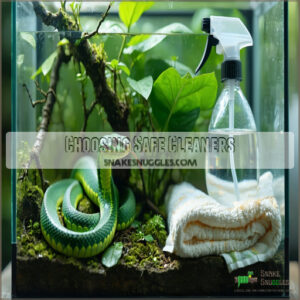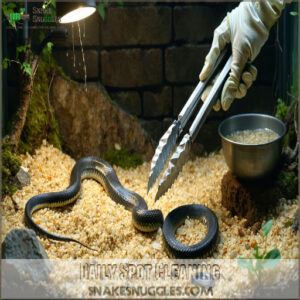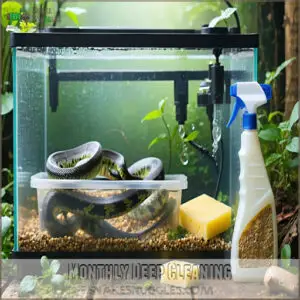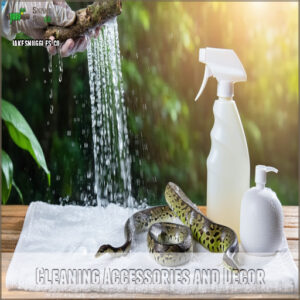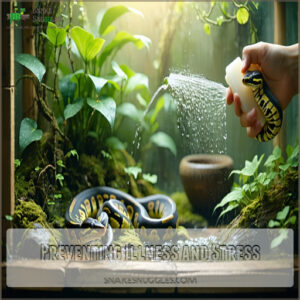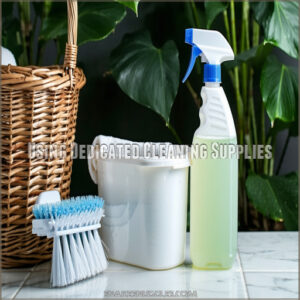This site is supported by our readers. We may earn a commission, at no cost to you, if you purchase through links.
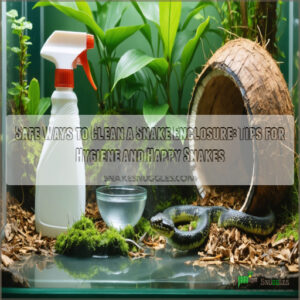 To clean your snake enclosure safely, start with daily spot cleaning—remove waste, soiled bedding, and uneaten food to keep bacteria and odors at bay.
To clean your snake enclosure safely, start with daily spot cleaning—remove waste, soiled bedding, and uneaten food to keep bacteria and odors at bay.
Scrub the water bowl daily with hot water and mild soap. Deep clean every 2-4 months by removing your snake, disposing of old substrate, and scrubbing all surfaces with warm, soapy water.
Use reptile-safe disinfectants like F10 or Chlorhexidine to sanitize hides and decor, then rinse thoroughly. Avoid chemical cleaners like bleach. Dedicated cleaning tools prevent cross-contamination.
Keeping a consistent routine guarantees your snake’s health stays supreme—there’s more to master for hassle-free cleaning ahead!
Table Of Contents
- Key Takeaways
- Cleaning Snake Enclosures
- Choosing Safe Cleaners
- Cleaning Procedures
- Preventing Illness and Stress
- Safe Handling and Cleaning Tips
- Frequently Asked Questions (FAQs)
- How do you clean a snake enclosure?
- Do snakes need to be cleaned?
- How often should you clean a snake enclosure?
- How do you clean a snake cage?
- What tools do you need to clean a snake?
- How do you keep a snake out of a room?
- What can I clean my snake tank with?
- What disinfectant is safe for snakes?
- How often should you clean your snake’s enclosure?
- Is Dawn dish soap safe for corn snakes?
- Conclusion
Key Takeaways
- Clean your snake’s enclosure daily by removing waste, refreshing water, and replacing soiled substrate to prevent bacteria buildup.
- Use reptile-safe disinfectants like F10 or a diluted vinegar-water mix for deep cleaning every 2-4 months, always rinsing thoroughly.
- Avoid harsh chemicals like bleach or scented cleaners, as they can harm your snake and cause stress.
- Use dedicated cleaning tools to avoid cross-contamination, and always let the enclosure dry completely before returning your snake.
Cleaning Snake Enclosures
Keeping your snake’s enclosure clean is essential for their health and happiness.
With daily spot cleaning and routine deep cleaning, you can create a safe and sanitary home for your scaly friend.
Importance of Daily Cleaning
Daily cleaning is key to keeping your snake healthy and stress-free.
Remove waste, soiled bedding, and uneaten food promptly—a clean environment prevents bacteria buildup and odors.
Maintain hygiene practices by washing the water bowl daily with hot water and mild soap.
A reliable cleaning schedule maintains proper snake health, making your enclosure a safe, welcoming space.
Keep cleaning simple but effective!
Frequency of Deep Cleaning
While daily cleaning handles mess promptly, deep cleaning is key for enclosure hygiene.
Proper snake enclosure cleanliness promotes snake health and longevity.
Follow this cleaning schedule:
- Deep clean tank every 2-4 months.
- Replace substrate monthly (or 2 months for durable types).
- Disinfect hides, logs, and walls weekly.
- Spot-clean daily for immediate sanitation.
- Adjust cleaning intervals based on waste and humidity.
Consistency keeps your snake’s habitat safe and fresh, and is essential for maintaining proper hygiene.
Bioactive Terrarium Cleaning
Bioactive terrariums require consistent Terrarium Maintenance for healthy ecosystems.
Spot clean waste to sustain Bioactive Substrates and Microbe Balance.
Different biomes require specific maintenance schedules for best health and cleanliness, so research your specific biome needs.
Annual deep cleaning maintains Tank Cycling without harming plants or cleaners.
| Task | Frequency | Tools Needed |
|---|---|---|
| Spot clean substrate | As needed | Gloves, scoop |
| Replace decayed plants | As required | Pruners, tongs |
| Disinfect water bowls | Weekly | Reptile-safe disinfectant |
Choosing Safe Cleaners
Choosing a safe cleaner for your snake’s enclosure is essential to keep your pet healthy and its habitat clean.
Stick with reptile-safe disinfectants or natural options, and avoid harsh chemicals that could harm your snake.
Reptile-Safe Disinfectants
Reptile-safe disinfectants are essential for keeping your snake healthy.
Here are three must-haves:
- Chlorhexidine Use: Effective against bacteria, easy to rinse.
- F10 Disinfectant: Safe for snakes, doesn’t leave harmful residues.
- Hydrogen Peroxide: A gentle, nontoxic snake cleaning option.
For a natural cleaning solution, consider safe reptile enclosure cleaning.
Avoid bleach or harsh chemicals. Soap alternatives, like Vinegar Solution, are safer for tanks.
Natural Cleaning Alternatives
Looking for natural cleaning methods? A vinegar-water mix works wonders as an eco-friendly, natural disinfectant.
You can buy vinegar cleaning solution products. Hot water paired with soap alternatives like baking soda tackles grime effectively.
A vinegar solution can deodorize and leave streak-free glass. For a gentle disinfect, try a vinegar spray—it’s nontoxic and reptile-safe.
These natural choices keep your snake’s habitat sparkling clean and safe.
Avoiding Harmful Chemicals
Steering clear of harmful chemicals keeps your snake safe.
Avoid toxic cleaners by sticking with reptile-safe disinfectants and natural disinfectant choices. Harmful cleaners like bleach or ammonia should never be used.
You can learn more about safe cleaning products for snake enclosures. Opt for chemical-free alternatives like vinegar-water mix or eco-friendly products.
Stick to these safe snake cleaning tips:
- Toxic-free cleaners
- Vinegar-water mix
- Non-toxic solutions
- Safe disinfectants
- Reptile-safe disinfectants
Cleaning Procedures
You’ve got to keep your snake’s enclosure clean to maintain a healthy, stress-free habitat.
Follow these simple steps for daily spot cleaning, monthly deep cleaning, and sanitizing decor to maintain a safe and sanitary environment.
Daily Spot Cleaning
Clean snake enclosures daily to keep your snake healthy. Start with waste removal—check for feces, urates, or soiled bedding. A clean environment prevents bacterial growth and disease.
Replace dirty water and clean bowls. Practice safe cleaning with mild soap or reptile-safe products.
Here’s a quick guide:
| Task | Frequency | Tools Needed | Benefit |
|---|---|---|---|
| Remove waste | Daily | Gloves, scooper | Reduces bacteria buildup |
| Clean water bowl | Daily | Soap, hot water | Maintains hydration, sanitation |
| Check substrate | As needed | Gloves | Prevents odors, stress |
| Replace water | Daily | Fresh water | Supports snake health |
Monthly Deep Cleaning
Once a month, start with Snake Relocation to a safe spot.
Remove the substrate completely, focusing on proper Substrate Removal. Scrub the enclosure with a reptile-safe disinfectant for thorough Tank Disinfection.
Don’t forget monthly bedding change during substrate replacement. For effective Enclosure Sanitizing, rinse and dry everything before returning your snake.
Keep the process calm to avoid stress.
Cleaning Accessories and Decor
When cleaning tank accessories, wear rubber gloves to protect your hands.
Start by removing hides, decorations, and other accessories. Use warm, soapy water for a thorough scrub, especially for cleaning hides and decor.
You can find specialty snake hide cleaners online.
Rinse well, then use a reptile-safe disinfectant for accessory sanitizing. Let everything dry completely before returning it to the enclosure.
Replace damaged decor for safety.
Preventing Illness and Stress
When you keep your snake’s enclosure clean, you reduce the risk of illnesses like scale rot and respiratory infections.
A clean, properly maintained habitat also helps your snake stay calm and stress-free.
Maintaining Proper Humidity
Proper humidity keeps your snake healthy.
Use a hygrometer to check moisture levels, as different species have specific humidity needs.
Adjust levels by misting, adding a moisture-retaining substrate, or using ventilation systems.
Water bowl cleaning daily also helps with humidity control.
Remember, improper moisture management can cause shedding problems or respiratory issues, so maintain the right balance for your snake.
Reducing Bacteria Buildup
To keep bacteria in check, schedule regular cleaning. Warm, humid enclosures can foster harmful microbes, risking infections.
Stay ahead with organized sanitary practices:
- Use reptile-safe disinfectants like chlorhexidine.
- Spot clean daily to remove waste.
- Maintain proper humidity with a hygrometer.
- Disinfect the snake tank monthly, wiping surfaces thoroughly.
- Avoid overwatering substrate to reduce bacteria buildup.
Proper maintenance is key to a healthy environment, and following these steps will help prevent infections and keep your snake’s home clean and safe, ensuring a long and healthy life for your pet.
Creating a Stress-Free Environment
Managing stress in your snake’s enclosure starts with consistency. Stick to a cleaning routine that balances hygiene and comfort.
Use safe reptile cleaning materials and keep the habitat quiet during disinfecting.
Maintain proper humidity management to maintain snake comfort. A stress-free environment depends on avoiding sudden changes and promoting stress reduction through timely care and the use of reptile-safe disinfectants.
Safe Handling and Cleaning Tips
When cleaning your snake’s enclosure, handle your snake carefully to keep both you and your pet safe.
Use the right tools and cleaning supplies to prevent mistakes and maintain a clean, healthy environment.
Handling Snakes During Cleaning
When cleaning a snake enclosure, safely remove the snake first to maintain stress reduction.
Use calm handling techniques and place it in temporary housing, like a ventilated plastic container.
Avoid sudden movements to maintain a stress-free environment.
Always support the snake’s body while handling, achieving snake safety.
This makes safe reptile cleaning effective and keeps snake care stress-free.
Using Dedicated Cleaning Supplies
A dedicated set of cleaning supplies avoids cross-contamination and enhances safe reptile disinfection.
Use tools only for the snake’s enclosure and keep them stored separately.
Here’s what to include:
- Brushes for scrubbing tough spots.
- Soap alternatives like chlorhexidine for equipment sanitizing.
- Spray bottles for reptile safe disinfectants.
- Buckets or tubs labeled for cleaning tools only.
This set of supplies helps in reptile safe disinfection and is essential for maintaining a clean environment for the snake, ensuring cross-contamination is avoided.
Avoiding Common Cleaning Mistakes
When cleaning snake enclosures, avoid common mistakes.
Never mix bleach with other cleaners—it creates toxic gas.
Skip scented products; strong odors stress snakes.
Rinse thoroughly to remove disinfectant residue.
Use reptile-safe disinfectants and dedicated supplies.
For a detailed guide, review safe cleaning product essentials.
| Cleaning Error | Risks Involved |
|---|---|
| Mixing Bleach | Toxic fumes |
| Skipping Rinsing | Harmful residue left behind |
| Using Scented Cleaners | Stressed, unwell snake |
| Improper Ventilation | Respiratory issues |
| Overcleaning Tank | Habitat instability |
Frequently Asked Questions (FAQs)
How do you clean a snake enclosure?
Think of it like spring cleaning—spot-clean daily to remove waste, replace soiled substrate, and refresh water.
Deep clean monthly by disinfecting hides, bowls, and surfaces.
Always rinse thoroughly, dry well, and keep things snake-safe!
Do snakes need to be cleaned?
Snakes don’t need to be cleaned, but their enclosure does.
Regular cleaning keeps them healthy and stress-free, as dirty habitats can lead to infections or illnesses.
Make certain a clean, safe environment for your slithery friend!
How often should you clean a snake enclosure?
You might think snakes don’t need much cleaning, but their enclosures should be spot-cleaned daily to remove waste.
Their enclosures should also be refreshed weekly or monthly, depending on substrate.
Deep clean every 2-4 months for ideal health.
How do you clean a snake cage?
Start by removing the snake, then clear out waste, soiled bedding, and decorations.
Wipe surfaces with hot soapy water or reptile-safe disinfectants.
Rinse thoroughly, dry completely, and return items after replacing fresh bedding.
What tools do you need to clean a snake?
Cleaning a snake is like giving it a spa day—keep it simple.
Use warm water (90-100°F), a clean, soft cloth, and a gentle touch.
Avoid soaps, and always dry the snake afterward.
How do you keep a snake out of a room?
Close doors and cover small gaps with towels to prevent escape routes.
Use a secure container, like a plastic bin with air holes, for temporary housing.
Never leave the snake unattended until it’s fully secure.
What can I clean my snake tank with?
You can clean your snake tank with hot water, mild soap, or reptile-safe disinfectants like chlorhexidine or diluted vinegar.
Avoid harsh chemicals like bleach unless diluted and rinsed thoroughly.
Always dry surfaces completely before use, ensuring a safe environment with reptile-safe disinfectants.
What disinfectant is safe for snakes?
Chlorhexidine and F10SC are excellent, reptile-safe disinfectants.
They’re effective against bacteria without harming your snake.
Hydrogen peroxide or a 50/50 vinegar-water mix also work well, but always rinse thoroughly and let surfaces dry completely, using disinfectants that are safe for your pet.
How often should you clean your snake’s enclosure?
You should spot-clean your snake’s enclosure daily for waste and water spills.
Replace bedding monthly (or as needed), and deep clean every 2-4 months to maintain a healthy, stress-free environment for your pet.
Is Dawn dish soap safe for corn snakes?
Think of Dawn dish soap as a gentle warrior against grime; it’s safe for corn snakes when diluted properly.
Use a small amount with warm water, rinse thoroughly, and make sure no residue remains.
Conclusion
Caring for a snake enclosure is like maintaining a car—it runs best with regular upkeep.
Safe ways to clean a snake enclosure include daily spot cleaning, deep cleaning every couple of months, and using reptile-safe disinfectants.
Avoid harsh chemicals, rinse everything well, and maintain consistent routines to reduce bacteria and stress for your pet.
Dedicate tools for cleaning, handle your snake carefully, and maintain proper humidity.
A clean habitat means a healthy, happy snake every time, and following these tips ensures a clean environment.
- https://www.tampavet.com/exotics-blog/cleaning-reptiles-habitat/
- https://oxyfresh.com/blogs/pet-health/snake-terrariums-101-your-guide-to-safe-cleaners
- https://www.zillarules.com/articles/how-to-clean-your-reptile-tank
- https://www.animalsathome.ca/how-to-clean-a-snake-tank/
- https://faq.dubiaroaches.com/articles/reptile-safe-cleaning-and-disinfecting-agents


